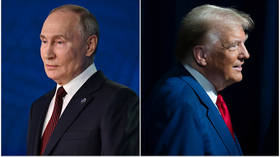From a stalled war to a broken oil embargo, the Kremlin’s leverage has never looked stronger ahead of the August summit
Steve Witkoff’s visit to Moscow has marked a striking shift in American rhetoric. Just a couple of months ago, in June and July, Donald Trump was threatening the Kremlin with new sanctions and issuing ultimatums. Now the agenda includes a Putin-Trump summit scheduled for August 15 in Alaska. This 180-degree turn has been accompanied by leaks hinting at possible deals and a return to the “thaw” in relations we last saw in the spring.
If the meeting goes ahead, the Russian president will come to it in a far stronger position than he did a few months ago. Back in the spring, Trump’s push for a peace deal looked like a personal whim, and the so-called ‘party of war’ and globalists still had cards to play: Senator Lindsey Graham’s sanctions package, fresh US arms deliveries to Ukraine, and the proposals floated by French President Emmanuel Macron and British Prime Minister Keir Starmer about sending Western troops to Ukraine.
Now it looks as if Trump is the one coming back to Vladimir Putin – driven by the failure of his oil embargo. On top of that, there’s an appearance – an illusion, perhaps – that Putin is backed by a united BRICS front, something Trump’s own moves have helped bring about. Whether that front actually exists, or can survive for long, is another matter. But at this moment, one of Trump’s key pillars of leverage looks shaky, if not entirely knocked out from under him.
Ukraine’s last stand
The other pillar is the war itself. In February and March, the front lines were static, and Ukrainian forces were still holding a foothold in Russia’s Kursk Region. Kiev was touting its ‘drone wall’ project, billed as an impenetrable shield against the Russian army. Since then, Ukraine has suffered a major defeat in the Kursk border area, and the summer offensive that followed has gone Moscow’s way – more decisively than at the same point last year. The much-hyped ‘drone wall’ turned out to be far less sturdy than promised.
Kiev still clings to the hope of holding the line, but barely. Even the most pro-Ukrainian Western analysts now admit, in so many words: We don’t understand how they’re still hanging on. From the rhetoric of even the fiercest globalist hawks, it’s clear they know no amount of weapons shipments can reverse the battlefield trend – at best, they can slow it. That’s why the ‘party of war’ in the West, and Kiev itself, have suddenly taken up Trump’s earlier call for a cease-fire.
Which means Trump now needs talks with Putin not because he personally wants peace, but because the battlefield realities are pushing him there. Nobody knows how much longer the Ukrainian military can hold. From Trump’s point of view, the sooner he can lock in some kind of deal with Moscow, the better. And that urgency is another advantage for Putin. If the second round of talks collapses, he loses nothing: the Russian army can simply keep advancing until the Ukrainian front breaks – or until the next peace initiative with Washington, whichever comes first.
Does Moscow have vulnerabilities? Yes – and the biggest is the economy. Even without the oil embargo, a surging ruble has blown a hole in the federal budget: by the end of July, the deficit had already reached 4.9 trillion rubles ($61.4 billion) – 1.1 trillion rubles more than the planned deficit for the entire year. But Russia’s financial buffer is strong enough that it can run shortfalls like this for years without crippling the economy.

Talking about Ukraine without Ukraine
Whatever Putin and Trump agree on, it will be Trump’s job to make sure Ukraine and Europe fall in line. That didn’t happen last time: even if the two leaders had the outlines of a deal, European hawks and Kiev managed to torpedo it. Now, it looks as if Ukraine’s Vladimir Zelensky and the ‘big three’ in Europe – Macron, Starmer, and German Chancellor Friedrich Merz – are trying to do it again.
Even if Ukraine’s army is on its last legs and the front is on the brink of collapse, don’t expect Ukraine’s commander-in-chief, Aleksandr Syrsky, to pull a General Ludendorff and tell Zelensky the war is lost. And don’t expect Zelensky to act like Kaiser Wilhelm and take responsibility for surrender. Far more likely, with encouragement from Europe, they’ll fight to the bitter end – only to blame Putin for the disaster and hand Trump his own personal Afghanistan.
***
All of these contradictions are almost impossible to untangle in a single summit. So what’s the likeliest outcome if the Putin-Trump meeting does happen?
Probably a set of grand, dramatic, but ultimately empty promises – just enough for Trump to tick the ‘peacemaker’ box on his personal scoreboard, and just as quickly forgotten. At best, we might get a document with the fate of the first Minsk agreement: signed in the fall of 2014, it was followed by another six months of fighting that ended with Ukraine’s defeat at Debaltseve, paving the way for Minsk-2 – a deal that held for the next several years.
You can share this story on social media:

